Rapid profiling of street drug samples on site with portable Near Infrared spectroscopy (pNIR)
Short desciption
The Trimbos institute in Utrecht is gathering and providing vital information on the Dutch illicit drug market to safeguard public health. To this end they provide drug checking for free and anonymous. The target audience is people who use drugs (PWUD) who want to be informed on potential risks regarding products they have acquired on the street or online. Many of the samples analysed by the Drugs Information and Monitoring System (DIMS) concern ecstacy tablets (containing MDMA as psychoactive substance) and to a lesser extent cocaine powders. Samples that have not been seen before are analyzed with GC-MS and LC-DAD in the laboratory. For ecstasy tablets a recognition list has been developed based on visual characteristics, so potential users are informed in the field in real-time [1]. This approach has several limitations and therefore DIMS is eager to develop and implement mobile techniques for more objective and accurate chemical analysis in the field. Portable NIR (near infrared spectroscopy) with the Powder Puck sensor and data analysis framework of the Dutch company TIPb has proven to be a very robust, easy to use, rapid (results within seconds), and reliable approach to obtain detailed chemical information of samples that contain drugs of abuse [2-4].
Required/ Recommended expertise
In this 6/9 month MSc research project you will be working with DIMS at the Trimbos Institute in Utrecht. You will be gathering portable NIR data from a wide range of ecstasy tablets and cocaine powders submitted by PWUD for analysis at one of the test services within the DIMS network. Confirmatory GC-MS and NMR analyses can be conducted at the Analytical Chemistry laboratory at UvA Science Park if needed. The main goal for this project is aimed at exploring the NIR spectrum as a characteristic chemical fingerprint of a material. Could this fingerprint be used to confirm compositional similarity to reference materials and to recognize batches of ecstasy pills, could this fingerprint be used to link products, and finally, could this fingerprint be used as an early alarm for new products and formulations that have entered the Dutch drug market? In addition to chemical analysis skills, the student we are looking for is also interested in and comfortable with advanced (multivariate) data analysis and machine learning.
Application procedure
If you want to apply for this research project, please send your CV, motivation and grade lists per e-mail to Laura Smit-Rigter. In your motivation letter, explain who you are, why you want to work on this project and how you hope to develop yourself.
References
1. Smit-Rigter and van der Gouwe. “The Drugs Information and Monitoring System (DIMS) factsheet on drug checking in the Netherlands.” (2019) www.trimbos.nl AF1677
2. Kranenburg, Ruben F et al. “A Calibration Friendly Approach to Identify Drugs of Abuse Mixtures with a Portable Near‐infrared Analyzer.” Drug testing and analysis 14.6 (2022): 1089–1101.
3. Kranenburg, Ruben F, Henk‐Jan Ramaker, and Arian C Asten. “On‐site Forensic Analysis of Colored Seized Materials: Detection of Brown Heroin and MDMA‐tablets by a Portable NIR Spectrometer.” Drug testing and analysis 14.10 (2022): 1762–1772.
4. Kranenburg, Ruben F et al. “The Importance of Wavelength Selection in On-Scene Identification of Drugs of Abuse with Portable near-Infrared Spectroscopy.” Forensic chemistry 30 (2022): 100437-.
Information
Institute / Company: Trimbos Instituut
City: Utrecht
Country: The Netherlands
Supervisor: Pieter Oomen
UVA Examiner: Arian van Asten
UVA Coordinator: Arian van Asten & Yorike Hartman
